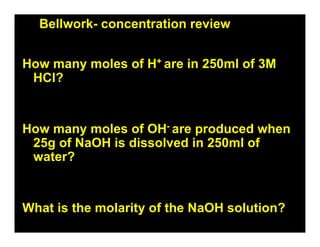
Lecture 19.1b- Bronsted-Lowry Acids & Bases
- 1. Bellwork- concentration review How many moles of H+ are in 250ml of 3M HCl? How many moles of OH- are produced when 25g of NaOH is dissolved in 250ml of water? What is the molarity of the NaOH solution?
- 2. Arrhenius concept Acids make H+ Bases make OH-
- 3. The Brønsted-Lowry definition of ACIDS AND BASES Acids donate protons (H+) HCl H+ + Cl- Bases accept protons (H+) NH3 + H+ NH4+
- 4. The Bronsted- Lowry model is more inclusive than the Arrhenius model. NH3 + H+ NH4+ Ammonia is a Bronsted-Lowry base, but does not dissociate to make OH-
- 5. 19.1 Why Ammonia is a Base
- 6. HA + H2O H3O+ + A- Acid base conjugate conjugate acid base An acid donates a proton forming its conjugate base. HA A- A base accepts a proton forming its conjugate acid. NH3 NH4+
- 7. HA A- Acid conjugate base A- is ready to accept a proton, it is a base. NH3 + H+ NH4+ Base conjugate acid NH4+ has a proton to donate. It is an acid.
- 8. 19.1 Conjugate Acids and Bases • A conjugate acid is the particle formed when a base gains a hydrogen ion. • A conjugate base is the particle that remains when an acid has donated a hydrogen ion.
- 9. •A conjugate acid-base pair consists of two substances related by the loss or gain of a single proton. •A substance that can act as both an acid and a base is said to be amphoteric.
- 10. Water is amphoteric. Water can be an acid or a base H2O H+ + OH- Water can ionize and donate a proton. H2O H3O+ As a base, water accepts a proton forming the hydronium ion.
- 11. A conjugate acid-base pair consists of two substances related to each other by the donating and accepting of a proton Are the following pairs conjugate acid- base pairs? a. H2O H3O+ b. OH- HNO3 c. HC2H3O2 C2H3O2-
- 12. 19.1 Brønsted-Lowry Acids and Bases
- 13. Identify conjugate acid base pairs HCl + NH3 NH4+ + Cl- HSO4- + OH- H2O + SO42- NH3 + H2O NH4+ + OH-
- 14. Lewis Acids and Bases Lewis definition an acid accepts a pair of electrons a base donates a pair of electrons.
- 15. 19.1 Lewis Acids and Bases • A Lewis acid is a substance that can accept a pair of electrons to form a covalent bond. • A Lewis base is a substance that can donate a pair of electrons to form a covalent bond.
- 16. Animation 25 Compare the three important definitions of acids and bases.
- 17. 19.1 Lewis Acids and Bases
- 18. 19.1 Section Quiz. 1. Which of the following is NOT a characteristic of acids? a. taste sour b. are electrolytes c. feel slippery d. affect the color of indicators
- 19. 19.1 Section Quiz. 2. Which compound is most likely to act as an Arrhenius acid? a. H2O b. NH3. c. NaOH. d. H2SO4.
- 20. 19.1 Section Quiz. 3. A Lewis acid is any substance that can accept a. a hydronium ion. b. a proton. c. hydrogen. d. a pair of electrons.
- 21. pH The pH scale measures the hydrogen ion concentration[H+] of a solution. A pH of 7 is neutral
- 22. A pH less than 7 is acidic (litmus red) A pH greater than 7 is basic (litmus blue) The pH scale ranges from below zero (very acidic) to above14 (very basic)
- 23. The pH scale is not linear. The pH scale is logarithmic. pH = -log[H+] [H+] = 1.0 x 10-2 pH = 2 very acidic [H+] = 1.0 x 10-3 pH = 3 acidic A solution with pH of 2 contains 10 times as much H+ as a solution with pH of 3.
- 24. Acidic = more H+ than OH- Basic = more OH- than H+
- 25. From pH 0 to pH 14 the H+ concentration decreases 100,000,000,000,000 times!!
- 26. 19.2 Measuring pH An indicator is a valuable tool for measuring pH because it is a different color in acidic solution than when in base.
- 27. 19.2 Measuring pH Phenolphthalein changes from colorless to pink at pH 7–9.
- 29. 19.2 Measuring pH Universal Indicators
- 30. 19.2 Measuring pH – pH Meters
- 31. Solu%on Red Blue pH paper Universal Acid, Litmus Litmus indicator Base, or neutral? lemon juice (diluted) !"#$%&"'( )*+(,&%-$.( /#$*(,&%-$.( 01(020*3( 4'&5*3.2#(&'+&62%"3( 76&+8(/2.*8("3('*$%32#9( #*-"'(:$&6*(;+&#$%*+<( ( ( ( ( ( baking soda + B( =2>&'?(."+2(@(1 A ( ( ( ( ( H2O C32'"(;+&#$%*+<( ( ( ( ( ( ,D."#(;+&#$%*+<( ( ( ( ( ( E&'*?23(( ( ( ( ( ( Drano (NaOH) ( ( ( ( ( ( (diluted) ( ( ( ( ( ( ( Lysol (diluted) Vinegar